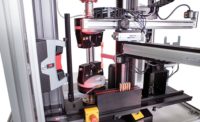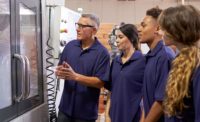In modern warehouses, people and machines work hand-in-hand to boost efficiency.
As businesses constantly refine their methods and gather data from various tools to get a clearer picture of how products move, they are increasingly reliant on automation.
From robots skilled in handling complex items, to self-driving vehicles in warehouses, and precise tracking systems, manufacturers are set to gain a clearer view of the entire supply chain.
“When it comes to automation for materials handling and traceability, we’re already seeing some exciting innovations on the horizon and in application,” says John Rosenberger, director, iWarehouse Gateway & Global Telematics, The Raymond Corp. “Think about robots that can handle extremely complex materials, autonomous vehicles navigating warehouses and high-tech tracking systems that can track items with pinpoint accuracy. These technologies will provide comprehensive insights into the movement and condition of materials throughout the supply chain.”
Robots have been used to load machines in factories for years. Traditionally, trained operators oversaw the manufacturing process. Now, advanced robots, particularly those that can sense force, along with automated measuring tools, are automating quality checks.
While older methods like probes and air gaging remain relevant, new high-precision technologies, like 2D optical and 3D laser scanners, are emerging. These systems can measure many points rapidly, allowing for thorough inspection of all produced parts, leading to better quality and less waste. Barcodes paired with software help track each part throughout its production journey.
“The result [is] improved quality and reduced scrap,” says Mark Bessler, business manager, custom gauging solutions, MSI-Viking. “Barcodes with data collection software allow manufacturers to track every part through the manufacturing process.”
Michael Muldoon, AV&R’s sales and business development director, says that manufacturers today need to be flexible and leverage their workforce to continuously improve their processes.
“Material handling and traceability will continue to be easier to implement, offer built in tools to manipulate large data sets, monitor each step of the process as it is happening and be more rapidly customizable,” he says. “By working towards this you will be able to unlock the potential of an existing workforce to use their knowledge to realize quality and efficiency gains.”
IoT, blockchain, and AI’s influence
Test & Inspection
IoT and its related data tools will help drive automation advancements as organizations collect data and use it to make real-time improvements. Many handling tools are now IoT-ready, sending and receiving data wirelessly.
“Many material handling products now come IoT-equipped to both accept new data and commands over the air (OTA) and to liberate data to larger process monitoring and control systems,” Rosenberger says. When paired with AI engines, it can improve operational efficiencies.
These tools enhance business transparency, streamline operations and protect against data tampering, especially in regulated industries, says Muldoon.
“These technologies are key to allowing businesses to offer greater transparency of their business, as they reduce miscommunication and department silos, and add protection against tampering with information and skewing results, and they greatly lower the cost of third-party audits for those companies working in regulated industries,” he says.
AI technology is being used to automatically detect defects in parts and assemblies, Bessler says.
“These are typically camera-based systems that are being trained in a similar way as an inspector might be trained to identify and isolate defective parts,” he explains. “Emerging 3D scanning technology is being used to detect and quantify defects in three dimensions. AI (Deep Learning) technology will significantly reduce the number of people required for these inspections while improving the product quality.”



